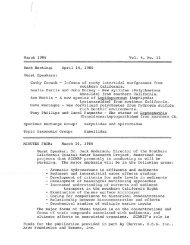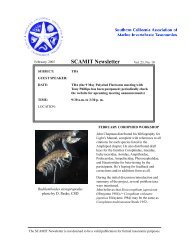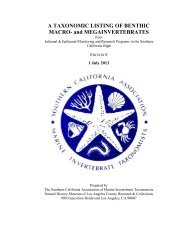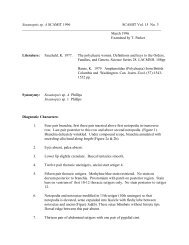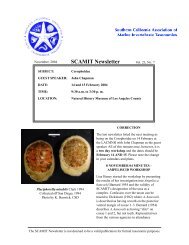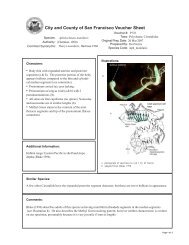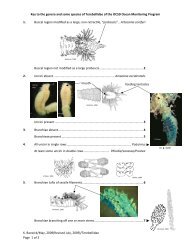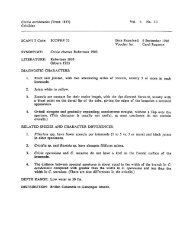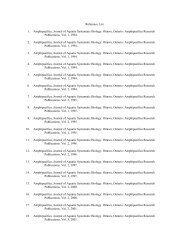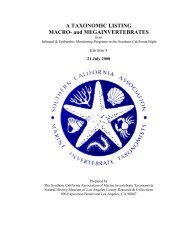Download - scamit
Download - scamit
Download - scamit
Create successful ePaper yourself
Turn your PDF publications into a flip-book with our unique Google optimized e-Paper software.
Caution is required in the use of this or any other "master species" list. Taxonomic listings do not in<br />
themselves constitute standardization of taxonomic usage. They are only tools that contribute to<br />
standardization, both as a product and in the process of their development and maintenance. Those<br />
responsible for developing regional monitoring should not attempt to impose on contributing surveys<br />
an artificially rigid taxonomy based upon a static list of standard names. Such an approach would<br />
inevitably lead to poorer quality survey data. Some differences in taxonomy and nomenclatural usage<br />
will continue to appear in data sets originating from contributing surveys. Most of these will reflect<br />
either change in the species encountered or new revisionary work. Some will represent non-standard<br />
usage despite efforts such as this listing and other activities of SCAMIT. Regional data-management<br />
systems must allow both growth and emendation to their species lists to conform to current usage.<br />
Ranasinghe et al (2003b) evaluated the success of quality assurance taxonomic standardization in the<br />
second regional monitoring survey (B’98) and provided some idea of both the value of the<br />
contributions to standardization made to date and the magnitude of the unresolved issues.<br />
COVERAGE OF EDITION 6<br />
This document provides a list of macroinvertebrates and megainvertebrates from both soft and hard<br />
bottom habitats of the Southern California Bight. Holoplanktonic species are not included in the list.<br />
For the purposes of the list, macroinvertebrates are defined as those organisms retained upon a 0.3<br />
mm or larger mesh screen. Epibenthic megainvertebrates are defined as benthic organisms captured in<br />
otter trawls and having a body dimension greater than 1 cm. The list draws from sampling programs<br />
that have been in existence since as early as 1970 (see table of contributors). Over that period,<br />
sampling frequencies and station locations have varied but<br />
gear types and methods have been stable. The list reflects<br />
the organisms collected from thousands of samples within Contributing Programs<br />
the habitats covered. Most records are from soft substrate<br />
on the inner to mid shelf within the SCB, but increasingly<br />
• City of Los Angeles, Bureau of Sanitation,<br />
information on other habitats from the intertidal to the<br />
Environmental Monitoring Division<br />
near-shore basins is also represented. Records in the<br />
published literature are not sufficient for inclusion, only<br />
actual examined specimens form the basis for this listing.<br />
There are 3004 species-level taxa on the list representing<br />
18 phyla, 39 classes, 122 orders, and 654 families; almost<br />
an 18% increase in included species over the previous<br />
edition.<br />
Geographic coverage is from Point Conception, California<br />
to Bahía Todos Santos, Baja California Sur, Mexico in<br />
depths to 1000 meters. As in previous editions, the<br />
information base from which the list is derived is primarily<br />
survey data collected in the environmental monitoring<br />
programs of publicly owned wastewater treatment works<br />
(POTWs). Therefore, coverage within the Bight is biased<br />
by the distribution of sampling efforts associated with<br />
these programs. The largest of these are centered on the<br />
metropolitan areas of Los Angeles/Orange County and San<br />
Diego. The fauna occurring at shelf and upper slope depths<br />
in these areas is well represented. North of the Los<br />
Angeles region, monitoring programs are fewer in number<br />
and smaller in scale. Consequently, the fauna of the<br />
northern area of the Bight is under-represented. Records<br />
from Regional Monitoring Surveys (Allen et al. 1998,<br />
2002, 2007; Bergen et al. 1998; Ranasinghe et al. 2003a,<br />
2007) improve coverage in this northern region as well as<br />
LARGE DISCHARGE MONITORING PROGRAMS<br />
• County Sanitation Districts of Los Angeles<br />
County<br />
• Orange County Sanitation District<br />
• City of San Diego, Public Utilities Department<br />
SMALL DISCHARGE MONITORING PROGRAMS<br />
• Goleta Sanitary District<br />
• City of Santa Barbara<br />
• Carpenteria Sanitary District<br />
• City of Oxnard<br />
• South East Regional Reclamation Authority<br />
• City of Oceanside<br />
• Encina Water Pollution Control Facility<br />
• San Elijo Joint Powers Authority<br />
• City of Avalon<br />
• Int’nl Treatment Plant, South Bay Outfall<br />
MISCELLANEOUS STUDIES<br />
• Terminal Island Treatment Plant Outfall Study<br />
• Tijuana Ocean Engineering Study<br />
• LACSD Reference Survey<br />
• CSDMWWD Variability Study<br />
REGIONAL SURVEYS<br />
• Southern California Coastal Water<br />
Research Project Reference Surveys<br />
• 1994 Southern California Bight Pilot Project<br />
(SCBPP)<br />
Edition 6 2 1 July 2011



